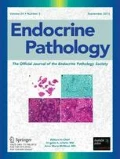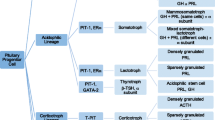Abstract
The genetic mutations underlying familial syndromes that include pituitary tumors are rarely noted in the majority of sporadic adenohypophyseal adenomas. In contrast, epigenetic dysregulation is common, resulting in differential expression of cell cycle and apoptosis regulators, adhesion molecules, growth factors, and metabolic determinants of cell function. Here, we discuss the diagnostic and therapeutic implications of these findings as the landscape of pituitary tumor defects unfolds.
Similar content being viewed by others
References
Vallar L, Spada A, Giannattasio G. Altered Gs and adenylate cyclase activity in human GH-secreting pituitary adenomas. Nature 1987; 330:566–568.
Landis CA, Masters SB, Spada A, Pace AM, Bourne HR, Vallar L. GTPase inhibiting mutations activate the alpha-chain of Gs and stimulate adenylate cyclase in human pituitary tumors. Nature 1989; 340:692–696.
Spada A, Arosio M, Bochicchio D et al. Clinical, biochemical and morphological correlates in patients bearing growth hormone-secreting pituitary tumors with or without constitutively active adenylyl cyclase. J Clin Endocrinol Metab 1990; 71:1421–1426.
Bhayana S, Booth GL, Asa SL, Kovacs K, Ezzat S. The implication of somatotroph adenoma phenotype to somatostatin analog responsiveness in acromegaly. J Clin Endocrinol Metab 2005; 90(11):6290–6295.
Asa SL, DiGiovanni R, Jiang J et al. A growth hormone receptor mutation impairs growth hormone autofeedback signaling in pituitary tumors. Cancer Res 2007; 67(15):7505–7511.
Chandrasekharappa SC, Guru SC, Manickam P et al. Positional cloning of the gene for multiple endocrine neoplasia-type 1. Science 1997; 276:404–407.
Zhuang Z, Ezzat S, Vortmeyer AO et al. Mutations of the MEN1 tumor suppressor gene in pituitary tumors. Cancer Res 1997; 57:5446–5451.
Asa SL, Somers K, Ezzat S. The MEN-1 gene is rarely down-regulated in pituitary adenomas. J Clin Endocrinol Metab 1998; 83:3210–3212.
Georgitsi M, Raitila A, Karhu A et al. Germline CDKN1B/p27Kip1 mutation in multiple endocrine neoplasia. J Clin Endocrinol Metab 2007; 92(8):3321–3325.
Agarwal SK, Mateo CM, Marx SJ. Rare germline mutations in cyclin-dependent kinase inhibitor genes in multiple endocrine neoplasia type 1 and related states. J Clin Endocrinol Metab 2009; 94(5):1826–1834.
Pellegata NS, Quintanilla-Martinez L, Siggelkow H et al. Germ-line mutations in p27Kip1 cause a multiple endocrine neoplasia syndrome in rats and humans. Proc Natl Acad Sci U S A 2006; 103(42):15558–15563.
Soares BS, Frohman LA. Isolated familial somatotropinoma. Pituitary 2004; 7(2):95–101.
Beckers A, Daly AF. The clinical, pathological, and genetic features of familial isolated pituitary adenomas. Eur J Endocrinol 2007; 157(4):371–382.
Vierimaa O, Georgitsi M, Lehtonen R et al. Pituitary adenoma predisposition caused by germline mutations in the AIP gene. Science 2006; 312(5777):1228–1230.
Georgitsi M, De Menis E, Cannavo S et al. Aryl hydrocarbon receptor interacting protein (AIP) gene mutation analysis in children and adolescents with sporadic pituitary adenomas. Clin Endocrinol (Oxf) 2008; 69(4):621–627.
Carney JA, Gordon H, Carpenter PC, Shenoy BV, Go VL. The complex of myxomas, spotty pigmentation, and endocrine overactivity. Medicine (Baltimore) 1985; 64(4):270–283.
Kirschner LS, Carney JA, Pack SD et al. Mutations of the gene encoding the protein kinase A type I-alpha regulatory subunit in patients with the Carney complex. Nat Genet 2000; 26(1):89–92.
Yin Z, Williams-Simons L, Parlow AF, Asa S, Kirschner LS. Pituitary-specific knockout of the Carney complex gene prkar1a leads to pituitary tumorigenesis. Mol Endocrinol 2008; 22(2):380–387.
Tateno T, Asa SL, Zheng L, Mayr T, Ullrich A, Ezzat S. The FGFR4-G388R Polymorphism Promotes Mitochondrial STAT3 Serine Phosphorylation to Facilitate Pituitary Growth Hormone Cell Tumorigenesis. PLoS Genet 2011; 7(12):e1002400.
Pei L, Melmed S. Isolation and characterization of a pituitary tumor-transforming gene (PTTG). Mol Endocrinol 1997; 11:433–441.
Zhang X, Sun H, Danila DC et al. Loss of expression of GADD45 gamma, a growth inhibitory gene, in human pituitary adenomas: implications for tumorigenesis. J Clin Endocrinol Metab 2002; 87(3):1262–1267.
Evans CO, Reddy P, Brat DJ et al. Differential expression of folate receptor in pituitary adenomas. Cancer Res 2003; 63(14):4218–4224.
Moreno CS, Evans CO, Zhan X, Okor M, Desiderio DM, Oyesiku NM. Novel molecular signaling and classification of human clinically nonfunctional pituitary adenomas identified by gene expression profiling and proteomic analyses. Cancer Res 2005; 65(22):10214–10222.
Zhao J, Dahle D, Zhou Y, Zhang X, Klibanski A. Hypermethylation of the promoter region is associated with the loss of MEG3 gene expression in human pituitary tumors. J Clin Endocrinol Metab 2005; 90(4):2179–2186.
Wierinckx A, Auger C, Devauchelle P et al. A diagnostic marker set for invasion, proliferation, and aggressiveness of prolactin pituitary tumors. Endocr Relat Cancer 2007; 14(3):887–900.
Hussaini IM, Trotter C, Zhao Y et al. Matrix metalloproteinase-9 is differentially expressed in nonfunctioning invasive and noninvasive pituitary adenomas and increases invasion in human pituitary adenoma cell line. Am J Pathol 2007; 170(1):356–365.
Galland F, Lacroix L, Saulnier P et al. Differential gene expression profiles of invasive and non-invasive non-functioning pituitary adenomas based on microarray analysis. Endocr Relat Cancer 2010; 17(2):361–371.
McCormack AI, McDonald KL, Gill AJ et al. Low O6-methylguanine-DNA methyltransferase (MGMT) expression and response to temozolomide in aggressive pituitary tumours. Clin Endocrinol (Oxf) 2009; 71(2):226–233.
McCormack A, Kaplan W, Gill AJ et al. MGMT expression and pituitary tumours: relationship to tumour biology. Pituitary 2013; 16(2):208–219.
De M, I, Visone R, Wierinckx A et al. HMGA proteins up-regulate CCNB2 gene in mouse and human pituitary adenomas. Cancer Res 2009; 69(5):1844–1850.
D'Angelo D, Palmieri D, Mussnich P et al. Altered microRNA expression profile in human pituitary GH adenomas: down-regulation of miRNA targeting HMGA1, HMGA2, and E2F1. J Clin Endocrinol Metab 2012; 97(7):E1128-E1138.
Jacks T, Fazeli A, Schmitt EM, Bronson RT, Goodell MA, Weinberg RA. Effects of an Rb mutation in the mouse. Nature 1992; 359:295–300.
Cryns VL, Alexander JM, Klibanski A, Arnold A. The retinoblastoma gene in human pituitary tumors. J Clin Endocrinol Metab 1993; 77:644–646.
Pei L, Melmed S, Scheithauer B, Kovacs K, Benedict WF, Prager D. Frequent loss of heterozygosity at the retinoblastoma susceptibility gene (RB) locus in aggressive pituitary tumors: Evidence for a chromosome 13 tumor suppressor gene other than RB. Cancer Res 1995; 55:1613–1616.
Woloschak M, Yu A, Xiao J, Post KD. Abundance and state of phosphorylation of the retinoblastoma gene product in human pituitary tumors. Int J Cancer 1996; 67(1):16–19.
Bates AS, Farrell WE, Bicknell EJ et al. Allelic deletion in pituitary adenomas reflects aggressive biological activity and has potential value as a prognostic marker. J Clin Endocrinol Metab 1997; 82:818–824.
Nakayama K, Ishida N, Shirane M et al. Mice lacking p27Kip1 display increased body size, multiple organ hyperplasia, retinal dysplasia, and pituitary tumors. Cell 1996; 85:707–720.
Kiyokawa H, Kineman RD, Manova-Todorova KO et al. Enhanced growth of mice lacking the cyclin-dependent kinase inhibitor function of p27Kip1. Cell 1996; 85:721–732.
Fero ML, Rivkin M, Tasch M et al. A syndrome of multiorgan hyperplasia with features of gigantism, tumorigenesis, and female sterility in p27Kip1-deficient mice. Cell 1996; 85:733–744.
Franklin DS, Godfrey VL, Lee H et al. CDK inhibitors p18(INK4c) and p27(Kip1) mediate two separate pathways to collaboratively suppress pituitary tumorigenesis. Genes Dev 1998; 12(18):2899–2911.
Bamberger CM, Fehn M, Bamberger AM et al. Reduced expression levels of the cell-cycle inhibitor p27Kip1 in human pituitary adenomas. Eur J Endocrinol 1999; 140(3):250–255.
Dahia PL, Aguiar RC, Honegger J et al. Mutation and expression analysis of the p27/kip1 gene in corticotrophin- secreting tumours. Oncogene 1998; 16(1):69–76.
Liu W, Asa SL, Ezzat S. Vitamin D and its analog EB1089 induce p27 accumulation and diminish association of p27 with Skp2 independent of PTEN in pituitary corticotroph cells. Brain Pathol 2002; 12(4):412–419.
Woloschak M, Yu A, Post KD. Frequent inactivation of the p16 gene in human pituitary tumors by gene methylation. Mol Carcinog 1997; 19(4):221–224.
Bahar A, Bicknell JE, Simpson DJ, Clayton RN, Farrell WE. Loss of expression of the growth inhibitory gene GADD45gamma, in human pituitary adenomas, is associated with CpG island methylation. Oncogene 2004; 23(4):936–944.
Bahar A, Simpson DJ, Cutty SJ et al. Isolation and characterization of a novel pituitary tumor apoptosis gene. Mol Endocrinol 2004; 18(7):1827–1839.
Zhu X, Mao X, Hurren R, Schimmer AD, Ezzat S, Asa SL. Deoxyribonucleic acid methyltransferase 3B promotes epigenetic silencing through histone 3 chromatin modifications in pituitary cells. J Clin Endocrinol Metab 2008; 93(9):3610–3617.
Ezzat S, Mader R, Yu S, Ning T, Poussier P, Asa SL. Ikaros integrates endocrine and immune system development. J Clin Invest 2005; 115(4):1021–1029.
Ezzat S, Mader R, Fischer S, Yu S, Ackerley C, Asa SL. An essential role for the hematopoietic transcription factor Ikaros in hypothalamic-pituitary-mediated somatic growth. Proc Natl Acad Sci U S A 2006; 103(7):2214–2219.
Ezzat S, Yu S, Asa SL. The zinc finger Ikaros transcription factor regulates pituitary growth hormone and prolactin gene expression through distinct effects on chromatin accessibility. Mol Endocrinol 2005; 19(4):1004–1011.
Ezzat S, Yu S, Asa SL. Ikaros isoforms in human pituitary tumors: distinct localization, histone acetylation, and activation of the 5′ fibroblast growth factor receptor-4 promoter. Am J Pathol 2003; 163(3):1177–1184.
Ezzat S, Zheng L, Zhu XF, Wu GE, Asa SL. Targeted expression of a human pituitary tumor-derived isoform of FGF receptor-4 recapitulates pituitary tumorigenesis. J Clin Invest 2002; 109(1):69–78.
Yu S, Asa SL, Ezzat S. Fibroblast growth factor receptor 4 is a target for the zinc-finger transcription factor Ikaros in the pituitary. Mol Endocrinol 2002; 16(5):1069–1078.
Yu S, Asa SL, Weigel RJ, Ezzat S. Pituitary tumor AP-2alpha recognizes a cryptic promoter in intron 4 of fibroblast growth factor receptor 4. J Biol Chem 2003; 278(22):19597–19602.
Ezzat S, Zheng L, Asa SL. Pituitary tumor-derived fibroblast growth factor receptor 4 isoform disrupts neural cell-adhesion molecule/N-cadherin signaling to diminish cell adhesiveness: a mechanism underlying pituitary neoplasia. Mol Endocrinol 2004; 18(10):2543–2552.
Ezzat S, Zhu X, Loeper S, Fischer S, Asa SL. Tumor-derived Ikaros 6 acetylates the Bcl-XL promoter to up-regulate a survival signal in pituitary cells. Mol Endocrinol 2006; 20(11):2976–2986.
Loeper S, Asa SL, Ezzat S. Ikaros modulates cholesterol uptake: A link between tumor suppression and differentiation. Cancer Res 2008; 68(10):3715–3723.
Dorman K, Shen Z, Yang C, Ezzat S, Asa SL. CtBP1 Interacts with Ikaros and Modulates Pituitary Tumor Cell Survival and Response to Hypoxia. Mol Endocrinol 2012; 26(3):447–457.
Author information
Authors and Affiliations
Corresponding author
Additional information
This paper summarizes the presentation on this subject from the Endocrine Pathology Society companion meeting at USCAP 2013.
Rights and permissions
About this article
Cite this article
Asa, S.L., Ezzat, S. Genomic Approaches to Problems in Pituitary Neoplasia. Endocr Pathol 25, 209–213 (2014). https://doi.org/10.1007/s12022-013-9276-5
Published:
Issue Date:
DOI: https://doi.org/10.1007/s12022-013-9276-5




